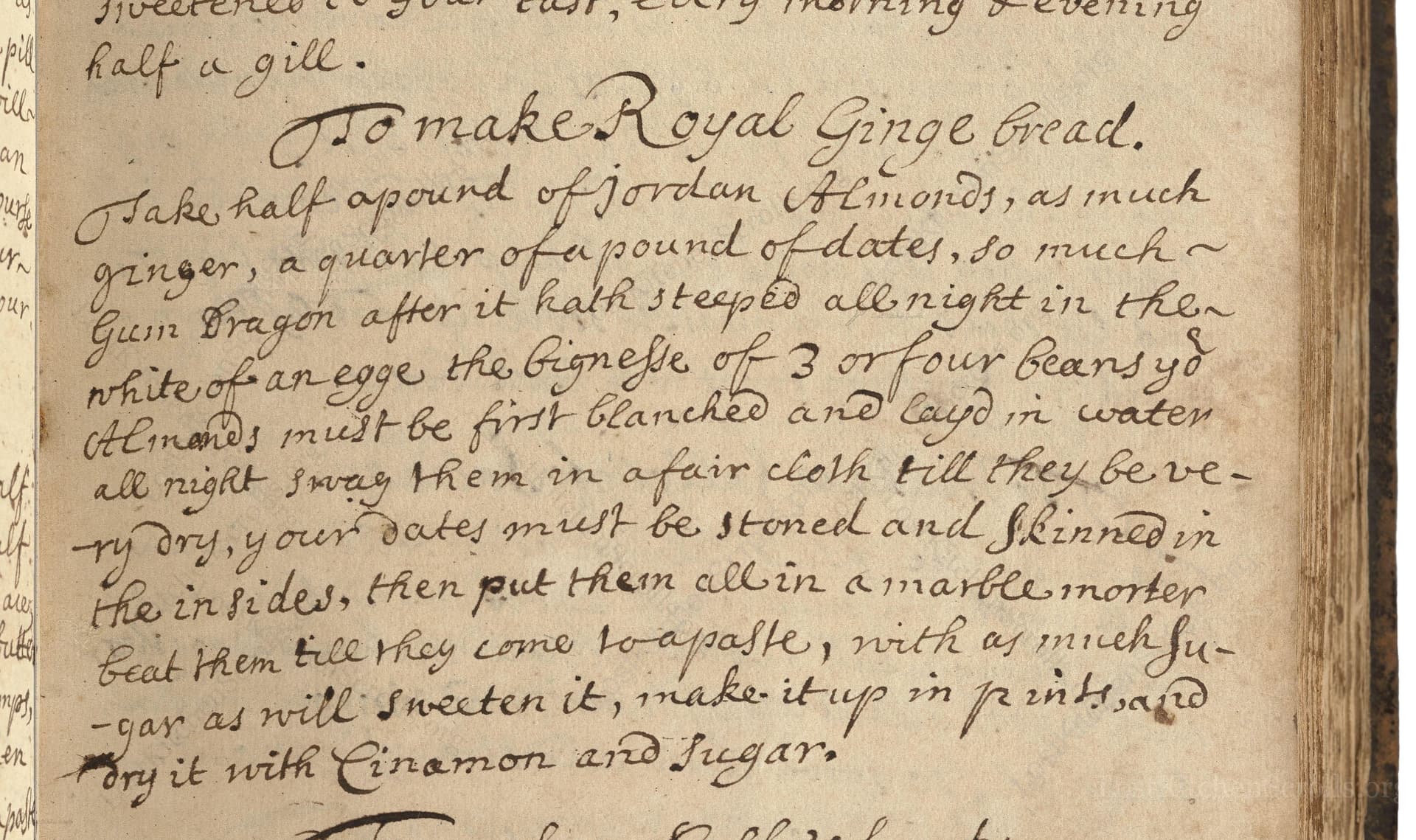To Make Royal Ginge Bread
From the treasured pages of Cookbook
Unknown Author

To Make Royal Ginge Bread
"Take half a pound of Jordan Almonds, as much ginger, a quarter of a pound of dates, so much Gum Dragon after it hath steeped all night in the white of an egge the bignesse of 3 or four beans yo almonds must be first blanched and layd in water all night sway them in a fair cloth till they be very dry, your dates must be stoned and skinned in the in sides, then put them all in a marble morter Beat them till they come to a paste, with as much sugar as will sweeten it, make it up in prints, and dry it with Cinamon and Sugar."
Note on the Original Text
The recipe’s structure is practical and direct, with instructions embedded in ingredient descriptions. Spelling and terminology reflect early 18th-century English—'sway them' means to wring or dry thoroughly, and 'Gum Dragon' is now known as gum tragacanth. Punctuation is minimal, and quantities are based on visual judgment and tactile experience. Emphasis on soaking, drying, and manual grinding comes from a pre-industrial kitchen reliant on labor and tradition.

Title
Cookbook (1706)
You can also click the book image above to peruse the original tome
Writer
Unknown
Era
1706
Publisher
Unknown
Background
Step back to the early 18th century with this charming culinary collection, brimming with period recipes that tantalize the tastebuds and offer a delicious glimpse into historic kitchens.
Kindly made available by
Folger Shakespeare Library
This recipe comes from around 1706—a time when sugar and exotic spices were arriving in greater quantities into English kitchens. Royal Gingerbread, lavish with almonds, spice, and sugar, would have been a delicacy, associated with wealth and celebration. The use of 'Gum Dragon' (gum tragacanth) as a binder reflects elite sweetmeat traditions and a penchant for intricate food presentation at the tables of the well-to-do.

Originally, the cook would have used a marble or stone mortar and pestle to laboriously pound nuts, ginger, and fruit into a smooth paste. Fine mesh sieves and linen cloths were required for precise draining and drying. Hands and wooden paddles shaped the dough, while elaborate carved wooden molds (prints) gave decorative shapes. The drying was done in open air, possibly on slatted racks or shallow trays. No ovens or direct heat were needed—just patience and manual strength.
Prep Time
30 mins
Cook Time
0 mins
Servings
12
We've done our best to adapt this historical recipe for modern kitchens, but some details may still need refinement. We warmly welcome feedback from fellow cooks and culinary historians — your insights support the entire community!
Ingredients
- 8 oz Jordan almonds, blanched and soaked overnight
- 8 oz ginger (fresh, peeled—or candied ginger as substitute)
- 4 oz dates, pitted and peeled
- 0.4 oz (about 2.5–3 tsp) gum tragacanth (gum dragon), softened overnight in the white of one egg
- 3–3.5 oz caster sugar (to taste)
- Ground cinnamon, for dusting
- Extra sugar, for dusting
Instructions
- To make Royal Gingerbread with modern ingredients, begin with 8 ounces of blanched Jordan almonds.
- Soak them overnight, then pat fully dry.
- Prepare an equal amount (8 ounces) of fresh peeled ginger or, alternately, use 8 ounces of preserved or candied ginger if fresh is unavailable.
- Pit and peel about 4 ounces of dates, ensuring no skins remain.
- Take 0.4 ounces (about 2.5 to 3 teaspoons) of food-grade gum tragacanth (Gum Dragon), softened overnight in the white of one large egg.
- Blend all these ingredients together in a food processor or mortar and pestle, beating until they form a smooth, pliable paste.
- Sweeten with approximately 3 to 3.5 ounces of caster sugar to taste.
- Press or shape the paste into small cakes or decorative molds.
- Finally, dust with cinnamon and a little more sugar, then allow them to dry, uncovered, at room temperature until firm.
Estimated Calories
160 per serving
Cooking Estimates
Prepare the gingerbread by soaking almonds and gum tragacanth overnight, then blend with dates, ginger, and sugar to make a paste. You need about 30 minutes to prepare and shape the mixture. There is no cooking time needed. Each serving has about 160 calories, and the recipe makes about 12 servings.
As noted above, we have made our best effort to translate and adapt this historical recipe for modern kitchens, taking into account ingredients nowadays, cooking techniques, measurements, and so on. However, historical recipes often contain assumptions that require interpretation.
We'd love for anyone to help improve these adaptations. Community contributions are highly welcome. If you have suggestions, corrections, or cooking tips based on your experience with this recipe, please share them below.
Join the Discussion
Rate This Recipe
Dietary Preference
Main Ingredients

Den Bockfisch In Einer Fleisch Suppen Zu Kochen
This recipe hails from a German manuscript cookbook compiled in 1696, a time whe...

Die Grieß Nudlen Zumachen
This recipe comes from a rather mysterious manuscript cookbook, penned anonymous...

Ein Boudain
This recipe comes from an anonymous German-language manuscript cookbook from 169...

Ein Gesaltzen Citroni
This recipe, dating from 1696, comes from an extensive anonymous German cookbook...
Browse our complete collection of time-honored recipes



